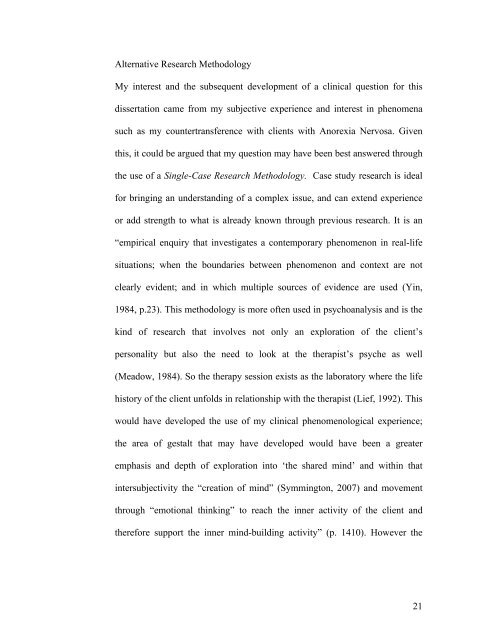“Ghosts at the banquet” - Scholarly Commons Home
“Ghosts at the banquet” - Scholarly Commons Home
“Ghosts at the banquet” - Scholarly Commons Home
Create successful ePaper yourself
Turn your PDF publications into a flip-book with our unique Google optimized e-Paper software.
Altern<strong>at</strong>ive Research Methodology<br />
My interest and <strong>the</strong> subsequent development of a clinical question for this<br />
dissert<strong>at</strong>ion came from my subjective experience and interest in phenomena<br />
such as my countertransference with clients with Anorexia Nervosa. Given<br />
this, it could be argued th<strong>at</strong> my question may have been best answered through<br />
<strong>the</strong> use of a Single-Case Research Methodology. Case study research is ideal<br />
for bringing an understanding of a complex issue, and can extend experience<br />
or add strength to wh<strong>at</strong> is already known through previous research. It is an<br />
“empirical enquiry th<strong>at</strong> investig<strong>at</strong>es a contemporary phenomenon in real-life<br />
situ<strong>at</strong>ions; when <strong>the</strong> boundaries between phenomenon and context are not<br />
clearly evident; and in which multiple sources of evidence are used (Yin,<br />
1984, p.23). This methodology is more often used in psychoanalysis and is <strong>the</strong><br />
kind of research th<strong>at</strong> involves not only an explor<strong>at</strong>ion of <strong>the</strong> client’s<br />
personality but also <strong>the</strong> need to look <strong>at</strong> <strong>the</strong> <strong>the</strong>rapist’s psyche as well<br />
(Meadow, 1984). So <strong>the</strong> <strong>the</strong>rapy session exists as <strong>the</strong> labor<strong>at</strong>ory where <strong>the</strong> life<br />
history of <strong>the</strong> client unfolds in rel<strong>at</strong>ionship with <strong>the</strong> <strong>the</strong>rapist (Lief, 1992). This<br />
would have developed <strong>the</strong> use of my clinical phenomenological experience;<br />
<strong>the</strong> area of gestalt th<strong>at</strong> may have developed would have been a gre<strong>at</strong>er<br />
emphasis and depth of explor<strong>at</strong>ion into ‘<strong>the</strong> shared mind’ and within th<strong>at</strong><br />
intersubjectivity <strong>the</strong> “cre<strong>at</strong>ion of mind” (Symmington, 2007) and movement<br />
through “emotional thinking” to reach <strong>the</strong> inner activity of <strong>the</strong> client and<br />
<strong>the</strong>refore support <strong>the</strong> inner mind-building activity” (p. 1410). However <strong>the</strong><br />
21
















